Caryn
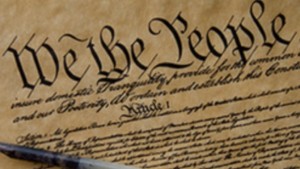 The Constitution has been in the news a lot these days, or shall I say, the violation of the Constitution. Sometimes I wonder if the signers of the Constitution would even be able to recognize the nation that they had envisioned when they wrote the Constitution. I happen to think they would not, but then even at the signing of the Constitution there was controversy. In that way, I suppose there would always be those who would do everything in their power to change or even do away with the Constitution. At the time of the Constitutional Convention in Philadelphia, only 38 of the 41 delegates present at its conclusion, agreed to sign the document. There were those, even then, who disagreed with what was laid out there. I suppose that is common in anything in life. Needless to say, it was a hard-won battle to win the ratification by the necessary nine out of thirteen US states in existence at the time.
The Constitution has been in the news a lot these days, or shall I say, the violation of the Constitution. Sometimes I wonder if the signers of the Constitution would even be able to recognize the nation that they had envisioned when they wrote the Constitution. I happen to think they would not, but then even at the signing of the Constitution there was controversy. In that way, I suppose there would always be those who would do everything in their power to change or even do away with the Constitution. At the time of the Constitutional Convention in Philadelphia, only 38 of the 41 delegates present at its conclusion, agreed to sign the document. There were those, even then, who disagreed with what was laid out there. I suppose that is common in anything in life. Needless to say, it was a hard-won battle to win the ratification by the necessary nine out of thirteen US states in existence at the time.
Before the Constitution, the United States was operating under the Articles of Confederation, which was ratified several months before the British surrender at Yorktown in 1781. The Articles of Confederation and Perpetual Union were an agreement among all thirteen original states in the United States of America. Basically it was the first constitution. Even when not yet ratified, the Articles provided a system for the Continental Congress to direct the American Revolutionary War, conduct diplomacy with Europe, and deal with territorial issues and Native American relations, but it was weak in that it didn’t allow for our president, a court system, or taxation, thereby leaving us with a weaker government. Congress was also given no authority to enforce its requests to the states for troops, giving us a weaker military force. Yet, even with the proposed changes, there were those who would disagreed with the proposed new Constitution.
When the Constitutional Convention was convened on May 25, 1787, the plan had been to amend the Articles 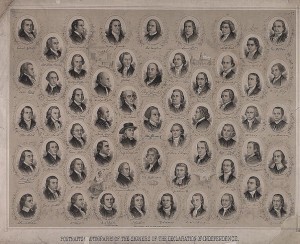 of Confederation, but that plan was quickly set aside in favor of writing a completely new Constitution. The meeting was held in Philadelphia’s Pennsylvania State House. It is now known as Independence Hall. Revolutionary War hero George Washington, a delegate from Virginia was elected as convention president. The debate was heated, but in the end, the delegates came up with a brilliant federal organization that boasted an intricate system of checks and balances. One of the main divisions in the discussions was that the more populated states wanted a state representation in Congress, and the smaller states wanted equal representation. That problem was solved by the Connecticut Compromise, which proposed a two chamber legislature with proportional representation in the lower house known as the House of Representatives and equal representation of the states in the upper house known as the Senate. It seemed a fair way to do it, but there are still those who disagree to this day.
of Confederation, but that plan was quickly set aside in favor of writing a completely new Constitution. The meeting was held in Philadelphia’s Pennsylvania State House. It is now known as Independence Hall. Revolutionary War hero George Washington, a delegate from Virginia was elected as convention president. The debate was heated, but in the end, the delegates came up with a brilliant federal organization that boasted an intricate system of checks and balances. One of the main divisions in the discussions was that the more populated states wanted a state representation in Congress, and the smaller states wanted equal representation. That problem was solved by the Connecticut Compromise, which proposed a two chamber legislature with proportional representation in the lower house known as the House of Representatives and equal representation of the states in the upper house known as the Senate. It seemed a fair way to do it, but there are still those who disagree to this day.
It would seem like they had an instant solution, but that wasn’t so. As dictated by Article VII, the document would not become binding until it was ratified by nine of the 13 states. On December 7, Delaware, Pennsylvania, New Jersey, Georgia, and Connecticut ratified the Constitution in quick succession. Other states, especially Massachusetts, opposed the Constitution, because it failed to reserve undelegated powers to the states and lacked constitutional protection of basic political rights, such as freedom of speech, religion, and the press, which I personally agree with. By February 1788, they had reached a compromise under which Massachusetts and other states would agree to ratify the document and that amendments would immediately be added to provide the protections they proposed. The Constitution was then narrowly ratified in Massachusetts. Maryland and South Carolina quickly followed. On June 21, 1788, New Hampshire became the ninth state to ratify the document, and it was agreed that government under the US Constitution would begin on March 4, 1789. In June, Virginia ratified the Constitution, followed by New York in July. The Constitution was signed on this day, September 17, 1787.
As promised, on September 25, 1789, the first Congress of the United States adopted 12 amendments to the 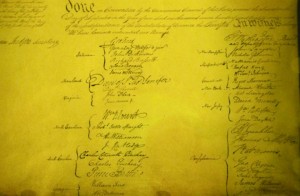 US Constitution, called the Bill of Rights. The Bill of Rights was then sent to the states for ratification. Ten of these amendments were ratified in 1791. In November 1789, North Carolina became the 12th state to ratify the US Constitution. Rhode Island, which opposed federal control of currency and was critical of compromise on the issue of slavery, resisted ratifying the Constitution until the US government threatened to sever commercial relations with the state. On May 29, 1790, Rhode Island voted by two votes to ratify the document, and the last of the original 13 colonies joined the United States. Today, the US Constitution is the oldest written constitution in operation in the world. That should say something, and it should be reason to protect it.
US Constitution, called the Bill of Rights. The Bill of Rights was then sent to the states for ratification. Ten of these amendments were ratified in 1791. In November 1789, North Carolina became the 12th state to ratify the US Constitution. Rhode Island, which opposed federal control of currency and was critical of compromise on the issue of slavery, resisted ratifying the Constitution until the US government threatened to sever commercial relations with the state. On May 29, 1790, Rhode Island voted by two votes to ratify the document, and the last of the original 13 colonies joined the United States. Today, the US Constitution is the oldest written constitution in operation in the world. That should say something, and it should be reason to protect it.
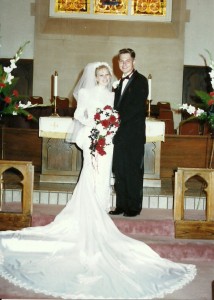
 In their first twenty years of marriage, my daughter, Amy Royce and her husband Travis lived here in Casper, Wyoming, where they raised their two children, Shai and Caalab, but Travis had always wanted to live somewhere else, and Amy was pretty tired of the harsher winters we have here. So, when their son Caalab, their youngest child, graduated from high school, they decided to make the move to a different climate…at least a little bit different one. Seattle, Washington still has the changes of season, but winter is shorter and has less snow and more rain. Amy loves the rain, you see…so much so, that it is very difficult for her to stay indoors when it rains, because all she can think of is driving in the rain. That said, they chose the Rainforest of western Washington as their location of choice to spend their next twenty years.
In their first twenty years of marriage, my daughter, Amy Royce and her husband Travis lived here in Casper, Wyoming, where they raised their two children, Shai and Caalab, but Travis had always wanted to live somewhere else, and Amy was pretty tired of the harsher winters we have here. So, when their son Caalab, their youngest child, graduated from high school, they decided to make the move to a different climate…at least a little bit different one. Seattle, Washington still has the changes of season, but winter is shorter and has less snow and more rain. Amy loves the rain, you see…so much so, that it is very difficult for her to stay indoors when it rains, because all she can think of is driving in the rain. That said, they chose the Rainforest of western Washington as their location of choice to spend their next twenty years.
Amy has been one of my very capable helpers when it came to taking care of her grandparents, but that time 
 of need is pretty much in the past now, as is their obligation as parents to get their children through school. That puts this couple is a place of few obligations, and being debt free, which sets them very free. They can make their decisions based on the fun things they want to do, and not the best place to raise their kids or the best schools to send them too…although I’m not saying that Seattle wouldn’t have fit the bill on both of those items either. Nevertheless, I am thankful that they raised their children here so I could watch them grow up and really get to know them before they moved away. Their daughter, Shai Royce decided that she didn’t want to move, and so she still lives here. Their son, Caalab made the move and will go to school there. I miss him very much.
of need is pretty much in the past now, as is their obligation as parents to get their children through school. That puts this couple is a place of few obligations, and being debt free, which sets them very free. They can make their decisions based on the fun things they want to do, and not the best place to raise their kids or the best schools to send them too…although I’m not saying that Seattle wouldn’t have fit the bill on both of those items either. Nevertheless, I am thankful that they raised their children here so I could watch them grow up and really get to know them before they moved away. Their daughter, Shai Royce decided that she didn’t want to move, and so she still lives here. Their son, Caalab made the move and will go to school there. I miss him very much.
For their twentieth anniversary, they decided to renew their vows in a ceremony on the beach…a very romantic idea. So, the plans were made and the guests invited, and today I find myself and my husband, Bob in the 
 Seattle suburb of Lynnwood, looking forward to a lovely ceremony on Saturday evening. The renewal of vows is such a deep expression of the love two people have shared for a long time, and one I highly recommend. Bob and I renewed ours at sea on a cruise we took for our twenty fifth anniversary. It was amazing, as I know their beach ceremony will be. Amy and Travis have always loved the beach…especially at sunset, which is well documented by all of her beach sunset pictures. Today is Amy and Travis’ 20th Anniversary. Happy Anniversary Amy and Travis!! We love you both very much!!
Seattle suburb of Lynnwood, looking forward to a lovely ceremony on Saturday evening. The renewal of vows is such a deep expression of the love two people have shared for a long time, and one I highly recommend. Bob and I renewed ours at sea on a cruise we took for our twenty fifth anniversary. It was amazing, as I know their beach ceremony will be. Amy and Travis have always loved the beach…especially at sunset, which is well documented by all of her beach sunset pictures. Today is Amy and Travis’ 20th Anniversary. Happy Anniversary Amy and Travis!! We love you both very much!!
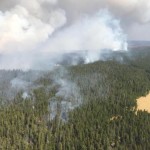
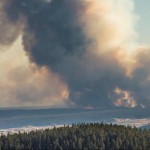 There is a fire burning in Yellowstone National Park. There are fires burning all over the western United States, as a matter of fact, but this particular fire bring back memories of the last big fire in Yellowstone National Park, and just how upset everyone was over the Let It Burn policy. Now, here we are again with a lightning caused fire burning in Yellowstone National Park, and no effort being made to fight it…unless structures end up being in danger of destruction.
There is a fire burning in Yellowstone National Park. There are fires burning all over the western United States, as a matter of fact, but this particular fire bring back memories of the last big fire in Yellowstone National Park, and just how upset everyone was over the Let It Burn policy. Now, here we are again with a lightning caused fire burning in Yellowstone National Park, and no effort being made to fight it…unless structures end up being in danger of destruction.
As with the 1988 fire, they tell us that the Natural Burn policy, another name for the Let It Burn policy, is in effect for this fire. The biggest problem with that policy is, of course, is that a fire burning unchecked can get so far out of control that it burns beyond human ability to put it out. It becomes an impossible task. That is what happened in 1988, and the whole nation was angry about it. In the end, that fire burned 1.2 million acres. Many people had the impression that the Park Service had failed badly. Nearly a third of Yellowstone National Park was badly burned. The Park Service said that the situation was inevitable because of the drought. Still, most people, me included, felt that if they had tried to fight it sooner, they could have saved a lot of the park from the hideous scarring damage it ended up with.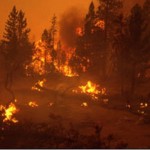

I understand that Yellowstone National Park has several fires each year, and that they usually burn themselves out in a short period of time, but in drought years, the Park Service simply can’t allow the fires to go. My concern with the current fire is that we are already at 2594 plus acres burned. How quickly is this fire going to get out of hand and how long before they will decide to do something about it?
The Yellowstone National Park fire of 1988 started in June and burned into November. It is a summer I will never forget. Our skies were constantly filled with smoke. The air stunk from the acrid smoke. It was hard for people to breathe. You couldn’t get away from it. I know this is how every person who lives in a fire area feels. I know I don’t have to explain this to anyone who has been around fires much. They already know more about wildfires than they ever wanted to.
The important thing for the government and the park service to remember is that the people of this nation love 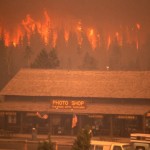
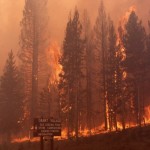 Yellowstone National Park, our oldest national park. It existed before the states where it is located were even states. I truly understand that fires are a natural part of the forest ecosystem, and that they get rid of dry brush that could bring about a worse fire, but I can’t see that it serves any good purpose to let 1.2 million acres of beautiful forest land burn and not even try to stop it. It destroys the homes of wildlife. It hurts the economy of the area it is in. All I ask is that the Park Service and the government remember just how important Yellowstone National Park is to the people of this nation.
Yellowstone National Park, our oldest national park. It existed before the states where it is located were even states. I truly understand that fires are a natural part of the forest ecosystem, and that they get rid of dry brush that could bring about a worse fire, but I can’t see that it serves any good purpose to let 1.2 million acres of beautiful forest land burn and not even try to stop it. It destroys the homes of wildlife. It hurts the economy of the area it is in. All I ask is that the Park Service and the government remember just how important Yellowstone National Park is to the people of this nation.
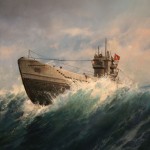 Submarines have been around a long time, but during the world wars, Germany built a submarine that was superior to any other submarine of the time. Called the U-Boat, the name was short for Unterseeboot, or under sea boat. Winston Churchill said, “the only thing that ever really frightened me during the war was the U-boat peril.” Churchill identified the threat that the U-Boats posed. The Atlantic Lifeline was vital to Britain’s survival. If Germany had been able to prevent merchant ships from carrying food, raw materials, troops and their equipment from North America to Britain, the outcome of World War II could have been very different. Britain might have been starved into submission, and her armies would not have been equipped with American built tanks and vehicles. The U-Boats were a serious threat. The Battle of the Atlantic was a must win situation. If Germany won that battle, Britain would likely have lost the war.
Submarines have been around a long time, but during the world wars, Germany built a submarine that was superior to any other submarine of the time. Called the U-Boat, the name was short for Unterseeboot, or under sea boat. Winston Churchill said, “the only thing that ever really frightened me during the war was the U-boat peril.” Churchill identified the threat that the U-Boats posed. The Atlantic Lifeline was vital to Britain’s survival. If Germany had been able to prevent merchant ships from carrying food, raw materials, troops and their equipment from North America to Britain, the outcome of World War II could have been very different. Britain might have been starved into submission, and her armies would not have been equipped with American built tanks and vehicles. The U-Boats were a serious threat. The Battle of the Atlantic was a must win situation. If Germany won that battle, Britain would likely have lost the war.
From 1918 on, Germany was not supposed to have submarines or submarine crews. However, no checks were in place to stop any research into submarines in Germany and it became clear that during the 1930’s, Germany had been investing time and men into submarine research. Their research and subsequent development of the U-Boat made it a submarine that was very difficult to locate and that made it extremely dangerous. They developed the Enigma machine, which was a series of electro-mechanical rotor cipher machines developed and  used in the early to early-mid twentieth century for commercial and military usage. Enigma was invented by the German engineer Arthur Scherbius at the end of World War I. The codes it could provide were difficult to decipher. German military messages enciphered on the Enigma machine were first broken by the Polish Cipher Bureau, in December 1932. This success was a result of efforts by three Polish cryptologists, Marian Rejewski, Jerzy Rózycki and Henryk Zygalski, working for Polish military intelligence. Rejewski reverse-engineered the device, using theoretical mathematics and material supplied by French military intelligence. Then, the three mathematicians designed mechanical devices for breaking Enigma ciphers, including the cryptologic bomb. In 1938, the Germans made the machine more complex, and increased complexity was repeatedly added to the Enigma machines, making decryption more difficult and requiring further equipment and personnel. It was more than the Poles could readily produce.
used in the early to early-mid twentieth century for commercial and military usage. Enigma was invented by the German engineer Arthur Scherbius at the end of World War I. The codes it could provide were difficult to decipher. German military messages enciphered on the Enigma machine were first broken by the Polish Cipher Bureau, in December 1932. This success was a result of efforts by three Polish cryptologists, Marian Rejewski, Jerzy Rózycki and Henryk Zygalski, working for Polish military intelligence. Rejewski reverse-engineered the device, using theoretical mathematics and material supplied by French military intelligence. Then, the three mathematicians designed mechanical devices for breaking Enigma ciphers, including the cryptologic bomb. In 1938, the Germans made the machine more complex, and increased complexity was repeatedly added to the Enigma machines, making decryption more difficult and requiring further equipment and personnel. It was more than the Poles could readily produce.
Finally there was a breakthrough. The astonishing achievements of the codebreakers of Bletchley Park saved countless lives. At their peak, there were 12,000 codebreakers at Bletchley Park, 8,000 of them women. The codebreakers helped bring victory in North Africa by giving British commander General Montgomery details of 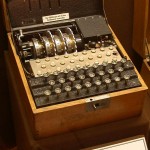 Erwin Rommel’s battle plans and providing the routes of the Nazi supply convoys. This allowed the Royal Navy the opportunity to sink them. Prior to the codebreakers, the U-Boats were only sunk after damage or near damage was done to other ships. Such was the case with the first sinking of a U-Boat. German submarine U-39 was a Type IXA U-boat of the Kriegsmarine that operated from 1938 to the first few days of World War II. On 14 September 1939, just 27 days after she began her first patrol, U-39 attempted to sink the British aircraft carrier HMS Ark Royal by firing two torpedoes at her. The torpedoes malfunctioned and exploded just short of the carrier. In retaliation, U-39 was immediately hunted down by three British destroyers. She was disabled with depth charges, and subsequently sunk. All crew members survived and were captured.
Erwin Rommel’s battle plans and providing the routes of the Nazi supply convoys. This allowed the Royal Navy the opportunity to sink them. Prior to the codebreakers, the U-Boats were only sunk after damage or near damage was done to other ships. Such was the case with the first sinking of a U-Boat. German submarine U-39 was a Type IXA U-boat of the Kriegsmarine that operated from 1938 to the first few days of World War II. On 14 September 1939, just 27 days after she began her first patrol, U-39 attempted to sink the British aircraft carrier HMS Ark Royal by firing two torpedoes at her. The torpedoes malfunctioned and exploded just short of the carrier. In retaliation, U-39 was immediately hunted down by three British destroyers. She was disabled with depth charges, and subsequently sunk. All crew members survived and were captured.
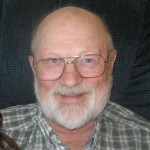
 A few days ago, a man commented on one of my stories, saying that he was Mary LuLu Taylor Leary Begier Warren’s great grandson. Joe Brown comes from her marriage to James Begier, the man she married after James Leary passed away. LuLu and James had three children, Minnie, John, and Mable. Mabel Claire married Edward Anthony Brown, and they had three children, Charles, Frank, and Mary. Frank Brown married Mary Lou Conway, and Frank Joseph (Joe) Brown is their son. Joe is my husband Bob Schulenberg’s second cousin once removed. Finding a new cousin is always exciting for me, but with the discovery of Joe, comes so much more. Joe brings with him a Gold Mine…a true Gold Mine. Joe has sent me pictures of his family, and his own drawings too. In return I have sent him pictures of our family and my in-laws family, so we are working on getting acquainted.
A few days ago, a man commented on one of my stories, saying that he was Mary LuLu Taylor Leary Begier Warren’s great grandson. Joe Brown comes from her marriage to James Begier, the man she married after James Leary passed away. LuLu and James had three children, Minnie, John, and Mable. Mabel Claire married Edward Anthony Brown, and they had three children, Charles, Frank, and Mary. Frank Brown married Mary Lou Conway, and Frank Joseph (Joe) Brown is their son. Joe is my husband Bob Schulenberg’s second cousin once removed. Finding a new cousin is always exciting for me, but with the discovery of Joe, comes so much more. Joe brings with him a Gold Mine…a true Gold Mine. Joe has sent me pictures of his family, and his own drawings too. In return I have sent him pictures of our family and my in-laws family, so we are working on getting acquainted.
Joe has been researching his family tree too, so we have a lot to talk about and a lot to share. He has access to a bunch of pictures from a part of Bob’s family that I know…some well, some only from my own research and stories from Bob’s grandmother, Vina Leary Schulenberg Hein. Joe, however, has much information, and many 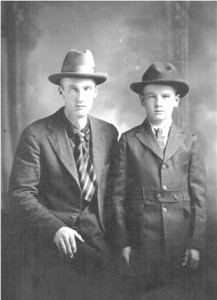
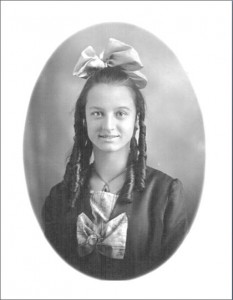 pictures…pictures of people I didn’t think I would ever have and pictures of people I know well, when they were just children. I am so overwhelmed by all this and his generosity, that it brings tears to my eyes. What a gift he has given me and the rest of the family too, as this story will serve to inform them of this amazing gift we have received. Overwhelming and amazing!! Receiving these pictures was like being given a part of our family back. I have often wondered what Bob’s grandma, Vina Leary Schulenberg Hein looked like when she was a girl. Now I know. She was a pretty girl with long ringlets. I have never seen a picture of her brother, and now I have several of them, including one with his wife, Rose Schulenberg Leary. And the only picture we had of Marion Chester Leary was the one I have used in stories in the past. My father-in-law only knew of that one. Now I have several of him too. And I have pictures of Chester’s half siblings Minnie Begier Morgan, John Begier, and Mable Claire Begier Brown. I have pictures of the history that has taken place in Forsyth, Montana, where much of Bob’s family history is centered. Of course I can’t include them all here, so they will be used in a future story. I simply could not feel more blessed.
pictures…pictures of people I didn’t think I would ever have and pictures of people I know well, when they were just children. I am so overwhelmed by all this and his generosity, that it brings tears to my eyes. What a gift he has given me and the rest of the family too, as this story will serve to inform them of this amazing gift we have received. Overwhelming and amazing!! Receiving these pictures was like being given a part of our family back. I have often wondered what Bob’s grandma, Vina Leary Schulenberg Hein looked like when she was a girl. Now I know. She was a pretty girl with long ringlets. I have never seen a picture of her brother, and now I have several of them, including one with his wife, Rose Schulenberg Leary. And the only picture we had of Marion Chester Leary was the one I have used in stories in the past. My father-in-law only knew of that one. Now I have several of him too. And I have pictures of Chester’s half siblings Minnie Begier Morgan, John Begier, and Mable Claire Begier Brown. I have pictures of the history that has taken place in Forsyth, Montana, where much of Bob’s family history is centered. Of course I can’t include them all here, so they will be used in a future story. I simply could not feel more blessed.
Joe has told me that he has much more information to share with me, and while I thought I didn’t have very much to share in return, I am finding that I have the continuing story on the Schulenberg side, at least, and he has the continuing family of his side. That is an amazing combination, and with the history that he knows, I 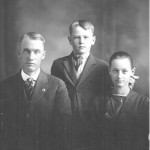
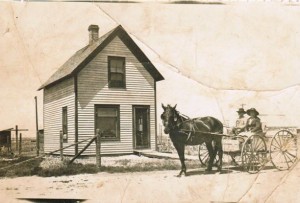 hope that I will be able to contribute some history too. Neither of us live in the area that we are talking about…Forsyth, Montana…and yet a lot of the family history took place there. What I do have is the stories told to me by my husband’s grandmother, our beloved Vina Leary Schulenberg Hein, and the stories told to me by my in-laws, Walt Schulenberg and Joann Knox Schulenberg. I am eager to share all of this history with Joe and his family, my family, and my readers. It’s going to be an incredible journey.
hope that I will be able to contribute some history too. Neither of us live in the area that we are talking about…Forsyth, Montana…and yet a lot of the family history took place there. What I do have is the stories told to me by my husband’s grandmother, our beloved Vina Leary Schulenberg Hein, and the stories told to me by my in-laws, Walt Schulenberg and Joann Knox Schulenberg. I am eager to share all of this history with Joe and his family, my family, and my readers. It’s going to be an incredible journey.
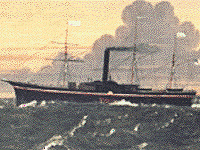 The San Francisco gold rush was a crazy time in American history. It was almost giddy in many ways. Gold does funny things to people. Just the thought of striking it rich made people pull up stakes and move west to try their hand at gold mining. Once people had made their fortunes, many decided to head back home to the east. Apparently the idea of wagon training back was not so appealing on the journey home, so these now, people of wealth decided to go by ship. The easiest crossing was through the Panama area. Of course, the Panama Canal was not built yet, although the French had tried to do so, but it wasn’t done yet. So the trip became a two ship journey.
The San Francisco gold rush was a crazy time in American history. It was almost giddy in many ways. Gold does funny things to people. Just the thought of striking it rich made people pull up stakes and move west to try their hand at gold mining. Once people had made their fortunes, many decided to head back home to the east. Apparently the idea of wagon training back was not so appealing on the journey home, so these now, people of wealth decided to go by ship. The easiest crossing was through the Panama area. Of course, the Panama Canal was not built yet, although the French had tried to do so, but it wasn’t done yet. So the trip became a two ship journey.
On August 20, 1857, several hundred passengers in San Francisco boarded the SS Sonora, of the Pacific Mail Steamship Line, and headed south toward Panama City. The 1857 value of the gold on board was 1.6 million, so just imagine today’s value. Thousands of freshly minted 1857-S double eagles, some earlier $20 coins, ingots, and gold in other forms were among the treasures. Some of the double eagles were stacked in long rows or columns and nestled in wooden boxes. Elsewhere around the ship, passengers had their own stash in purses and boxes reflecting their success in the land of gold. Once they arrived in Panama City, they were transported by train to on the Panama Railroad, which was a 48-mile line, completed in 1855 and had facilitated the crossing of the isthmus in about three or four hours as opposed to paddling and tramping through the jungles for several days. When the train arrived in Aspinwall, the passengers disembarked, and the treasure was transported to storage.
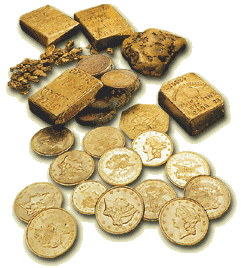 The next leg of the trip was aboard the side-wheel steamer SS Central America. The ship had been called the SS George Law, but the name was later changed to the SS Central America. It was now on its forty-fourth voyage for the Atlantic Mail Steamship Company. The Atlantic Mail Steamship Company was operating under federal mail contract to provide mail to the people between the east and west. The steamers had Navy captains at the helm, men of proven reputation and experience. Capt. William Herndon commanded the Central America.
The next leg of the trip was aboard the side-wheel steamer SS Central America. The ship had been called the SS George Law, but the name was later changed to the SS Central America. It was now on its forty-fourth voyage for the Atlantic Mail Steamship Company. The Atlantic Mail Steamship Company was operating under federal mail contract to provide mail to the people between the east and west. The steamers had Navy captains at the helm, men of proven reputation and experience. Capt. William Herndon commanded the Central America.
In early September 1857, the gold treasure was carefully packed aboard. The passengers found their cabins, and all were ready for the pleasant voyage to New York City. It was an ideal time of year for travel. A few days later, on September 7, 1857, the ship docked in the harbor of Havana. It was a popular stop for the passengers, who set about buying souvenirs and exploring the sights of the town. The trip toward New York continued to be pleasant. The skies were sunny and the sea smooth…temporarily.
At 5:30am on Wednesday, September 9, the ship’s second officer noted that the ship had gone 286 nautical miles in the preceding 26½ hours. He noted that a breeze was kicking up, and perhaps they were in for a storm, but expressed no concerns, because they were experienced and could handle a storm should it occur. That would prove to be the first mistake made. The storm grew furious and they were too far from a port to do much except keep the SS Central America into the waves. By Friday morning, September 11, the crew was still in control, but the ship was taking on water through the drive shaft, broken or open lights and elsewhere. The ship was tossing violently. It was virtually impossible to feed coal into the boilers.
At 11am Captain Herndon told the passengers that the ship was in grave danger. He enlisted the help of all men to bail water with a bucket brigade. By 1:00 in the afternoon the rising water in the hold doused the boiler 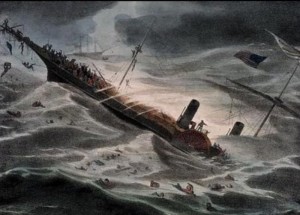 fires. The ship’s paddlewheels stopped. The SS Central America was at the mercy of the sea. By Saturday, the 12th of September, 1857, the storm started to pass, but it was too late. The SS Central America was doomed. The people were told to abandon ship, and the SS Central America went down with all of their treasure. In all, 425 lives were lost to the sea. Only 153 were pulled from a watery grave by the brig Marine, which was also damaged by the storm, though not to the degree of the SS Central America. The ship was discovered again on September 11, 1988, almost exactly 131 years after she went down in a hurricane on September 12, 1857. It was a rich find for Thomas G Thompson and his crew…and the museums who would reap much of the benefits.
fires. The ship’s paddlewheels stopped. The SS Central America was at the mercy of the sea. By Saturday, the 12th of September, 1857, the storm started to pass, but it was too late. The SS Central America was doomed. The people were told to abandon ship, and the SS Central America went down with all of their treasure. In all, 425 lives were lost to the sea. Only 153 were pulled from a watery grave by the brig Marine, which was also damaged by the storm, though not to the degree of the SS Central America. The ship was discovered again on September 11, 1988, almost exactly 131 years after she went down in a hurricane on September 12, 1857. It was a rich find for Thomas G Thompson and his crew…and the museums who would reap much of the benefits.
 As the fourteenth anniversary of the September 11th attacks approached, movies that had been filmed following those horrible events began to show up on television again. I think I’ve already watched each and every one of them, but I always feel compelled to watch them again. It isn’t out of a morbid sense of curiosity, but rather as a reminder that there are people out there who are so evil that it is beyond our ability to comprehend. It is also a way to remind myself that there are heroes out there who set aside self, no matter what the danger, in an effort to save others.
As the fourteenth anniversary of the September 11th attacks approached, movies that had been filmed following those horrible events began to show up on television again. I think I’ve already watched each and every one of them, but I always feel compelled to watch them again. It isn’t out of a morbid sense of curiosity, but rather as a reminder that there are people out there who are so evil that it is beyond our ability to comprehend. It is also a way to remind myself that there are heroes out there who set aside self, no matter what the danger, in an effort to save others.
I like to hope that I would be one of those people who come together to save others, but I don’t think that the average citizen really knows what they would do, until they are placed in that position. Our flight instincts seem to be based on just how big a danger we perceive ourselves to be facing. I don’t think that I could leave someone in trouble, but I don’t know how I would feel about actually running into a building like the World Trade Center on September 11.
As I was watching the movie, I was reminded that there were a number of people who were simply never found  at the World Trade Center site. Never found!! In fact, there were over 1000 people who were never found. It was like they were simply vaporized. Of course, there might be pieces of them in the many, some small enough to fit in a test tube, pieces of human remains that have not been identified. It is shocking and sad to me to think that there are actually people who have never been given closure concerning their loved ones. All they know is that their loved ones were killed on September 11, 2001. They don’t know if they suffered, or if it was instant. There is simply no way to know. And that is horrifically hard. I don’t mean to sound morbid, but I have a really hard time when I think about the fact that in just a few hours, more than 1,000 people simply disappeared. In our world of DNA matches and so many other methods of identifying people, and so many pieces of bodies that have been found, I just don’t understand how those people could simply be nowhere, but they are. I think that true closure often comes from being able to view the body, and have a funeral using the real body of the loved one. In the absence of that body, the mind plays tricks on us. We hope that maybe they somehow survived and simply have amnesia or something. Even though we know that is probably wrong.
at the World Trade Center site. Never found!! In fact, there were over 1000 people who were never found. It was like they were simply vaporized. Of course, there might be pieces of them in the many, some small enough to fit in a test tube, pieces of human remains that have not been identified. It is shocking and sad to me to think that there are actually people who have never been given closure concerning their loved ones. All they know is that their loved ones were killed on September 11, 2001. They don’t know if they suffered, or if it was instant. There is simply no way to know. And that is horrifically hard. I don’t mean to sound morbid, but I have a really hard time when I think about the fact that in just a few hours, more than 1,000 people simply disappeared. In our world of DNA matches and so many other methods of identifying people, and so many pieces of bodies that have been found, I just don’t understand how those people could simply be nowhere, but they are. I think that true closure often comes from being able to view the body, and have a funeral using the real body of the loved one. In the absence of that body, the mind plays tricks on us. We hope that maybe they somehow survived and simply have amnesia or something. Even though we know that is probably wrong.
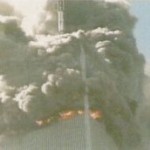
As this fourteenth anniversary of that horrible day arrives, I pray for those who lost loved ones, and those who will never know what happened to their loved ones. I pray that they are able to have emotional closure, even if they can’t have full closure. For the rest of us, I hope that we will never forget what happened that day, the people who died, and the people who did this. Terror and terrorists continue to exist in our world, and they don’t care if their victims were tolerant of their beliefs or not. They have one agenda, and one agenda only, to kill all infidels, because in their minds, that is their obligation and their right. We must stay alert, lest we find ourselves open to another attack.
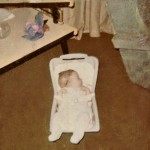 Into most little lives, a sibling must enter. Sometimes the baby is born into a family with other children, and so they just seem like a normal part of life, but sometimes as can be the case with the oldest child, that new little sibling is a bit of a culture shock. Still, most of the time the older child is very excited about this new little playmate, but sooner or later it occurs to the older child that this new little baby sure gets a lot of attention, or cries a lot, or is…basically very needy. That is the point when they become just a little bit disenchanted with this new little person, and they start to wonder why their parents decided to get this kid anyway. And sometimes they are very jealous of this new sibling, and really want the baby to be sent back. Oh they may still love them sometimes, but they sure can be annoying, and they sure take up a lot of Mommy’s and Daddy’s time. Time that used to be exclusively the older child’s time, and now must be shared.
Into most little lives, a sibling must enter. Sometimes the baby is born into a family with other children, and so they just seem like a normal part of life, but sometimes as can be the case with the oldest child, that new little sibling is a bit of a culture shock. Still, most of the time the older child is very excited about this new little playmate, but sooner or later it occurs to the older child that this new little baby sure gets a lot of attention, or cries a lot, or is…basically very needy. That is the point when they become just a little bit disenchanted with this new little person, and they start to wonder why their parents decided to get this kid anyway. And sometimes they are very jealous of this new sibling, and really want the baby to be sent back. Oh they may still love them sometimes, but they sure can be annoying, and they sure take up a lot of Mommy’s and Daddy’s time. Time that used to be exclusively the older child’s time, and now must be shared.
 For my niece Chantel Masterson Balcerzak, who really did love her sister, Toni Masterson Chase, and who I don’t really think ever felt a lot of resentment, I suppose it was really just a matter of letting everyone know that she was still there. Chantel was always a bit of a Diva, and so she liked her fair share of attention. She liked being the big sister, and helping her mom with the kids who came along after her, but just remember that she was still there, and she was after all…cute too. Of course, it wasn’t like anyone was going to forget that, because after all…Chantel was the first grandchild and the first niece, and we were all excited to have her here. Nevertheless, I suppose that when Toni came along, there was a bit of attention being paid to the new baby. So, our Chantel decided that it was time to remind us that she was the baby too.
For my niece Chantel Masterson Balcerzak, who really did love her sister, Toni Masterson Chase, and who I don’t really think ever felt a lot of resentment, I suppose it was really just a matter of letting everyone know that she was still there. Chantel was always a bit of a Diva, and so she liked her fair share of attention. She liked being the big sister, and helping her mom with the kids who came along after her, but just remember that she was still there, and she was after all…cute too. Of course, it wasn’t like anyone was going to forget that, because after all…Chantel was the first grandchild and the first niece, and we were all excited to have her here. Nevertheless, I suppose that when Toni came along, there was a bit of attention being paid to the new baby. So, our Chantel decided that it was time to remind us that she was the baby too.
That said, one day, Chantel saw Toni’s empty baby carrier, and decided that she would just show us that she 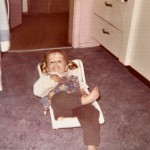 still fit the part of baby pretty well. So, she proceeded to plop down in the baby carrier, get her self situated in a very comfortable position, and flash that cute little smile of hers, as if to say, “I’n da baby too!!” Chantel was never a very big girl…in fact, fully grown, she is only 4’10”, so she really could fit in that baby carrier at two years old. I guess she proved her point. She could still play the part of a baby. Still, as the Diva part of Chantel continued to grow, she really didn’t want to take Toni’s place for very long, and as we all know, being the baby really can be kind of boring, especially when they are at the age of doing a lot of sleeping. That part didn’t interest Chantel very much at all. She was always a busy little girl, who had a lot of living to do. Sleeping was overrated. In the end, she opted for being the big sister over being the baby.
still fit the part of baby pretty well. So, she proceeded to plop down in the baby carrier, get her self situated in a very comfortable position, and flash that cute little smile of hers, as if to say, “I’n da baby too!!” Chantel was never a very big girl…in fact, fully grown, she is only 4’10”, so she really could fit in that baby carrier at two years old. I guess she proved her point. She could still play the part of a baby. Still, as the Diva part of Chantel continued to grow, she really didn’t want to take Toni’s place for very long, and as we all know, being the baby really can be kind of boring, especially when they are at the age of doing a lot of sleeping. That part didn’t interest Chantel very much at all. She was always a busy little girl, who had a lot of living to do. Sleeping was overrated. In the end, she opted for being the big sister over being the baby.
 As the summer comes to an end, the kids in the local school system head back to school. Some areas started earlier than ours. While I think school should start on the same date statewide, I am a firm supporter of school starting the Tuesday after Labor Day and ending the Friday before Memorial Day. Nevertheless, they didn’t ask me, and so here we are. School started on September 2, 2015 for the students of Natrona County, and that was the day my grandson went back to high school for his junior year.
As the summer comes to an end, the kids in the local school system head back to school. Some areas started earlier than ours. While I think school should start on the same date statewide, I am a firm supporter of school starting the Tuesday after Labor Day and ending the Friday before Memorial Day. Nevertheless, they didn’t ask me, and so here we are. School started on September 2, 2015 for the students of Natrona County, and that was the day my grandson went back to high school for his junior year.
My grandson, Josh Petersen is the last of my grandchildren to be in the public school system. It is strange to think that of him being the final one. Josh is a Junior at Kelly Walsh High School, and while he may not be totally looking forward to high school this year, he is pretty excited about the college classes he is taking through the Boces program. The college started on August 25, 2015. For those who don’t know, the Boces program takes surplus money that was not spent during the school year and gives it back to the students in the form of paid tuition for college classes. For students who are motivated to get ahead, the program is perfect. And Josh is very motivated to start working on his career.
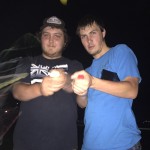 Josh has decided that he wants a career in firefighting and EMT. I have long thought Josh would be perfectly suited to either EMT or firefighting. He has been a caregiver for much of his young life, helping with the care of his great grandparents and doing that work in a careful, meticulous manner. He is such a caring young man, and I know that he will carry that into his work as a firefighter and EMT. His great grandparents noticed his special abilities right away. They could see that he paid careful attention to the directions for the care he was going to be giving, and then did exactly what he had been told. At one point, after he was trained to do the Epley Maneuver for Vertigo, his great grandpa, Walt Schulenberg said that Josh was the only one of the younger generation that he fully trusted with the treatment.
Josh has decided that he wants a career in firefighting and EMT. I have long thought Josh would be perfectly suited to either EMT or firefighting. He has been a caregiver for much of his young life, helping with the care of his great grandparents and doing that work in a careful, meticulous manner. He is such a caring young man, and I know that he will carry that into his work as a firefighter and EMT. His great grandparents noticed his special abilities right away. They could see that he paid careful attention to the directions for the care he was going to be giving, and then did exactly what he had been told. At one point, after he was trained to do the Epley Maneuver for Vertigo, his great grandpa, Walt Schulenberg said that Josh was the only one of the younger generation that he fully trusted with the treatment.
Josh is really enjoying his Intro to Fire Science and his Fire Fighting Strategy and Tactics I classes. He is the youngest student in his classes, and the only one who is still in high school. That just reinforces the determination he has for his career choice. He doesn’t want to wait two long years to get started on his training. He is ready to start now. He has had the  chance to visit the fire stations in town, and talk to the firefighters at length. He will also be involved in training at the training tower in town and in community service that the firefighters and trainees are involved in. He wants to do anything extra that he can too, so for the first time, he has chosen to donate blood. Josh wants to be a protector of life, and I am so proud of that desire in him. His training is only beginning, but everything he will be doing has served to get him more and more excited about his career choice. I think it is really awesome for Josh to be starting his college classes. I this he feels like he is finally starting his life’s work…even if he is just in the training stages right now. It’s an exciting time for him. Today is Josh’s birthday. Happy birthday Josh!! Have a great day!! We love you!!
chance to visit the fire stations in town, and talk to the firefighters at length. He will also be involved in training at the training tower in town and in community service that the firefighters and trainees are involved in. He wants to do anything extra that he can too, so for the first time, he has chosen to donate blood. Josh wants to be a protector of life, and I am so proud of that desire in him. His training is only beginning, but everything he will be doing has served to get him more and more excited about his career choice. I think it is really awesome for Josh to be starting his college classes. I this he feels like he is finally starting his life’s work…even if he is just in the training stages right now. It’s an exciting time for him. Today is Josh’s birthday. Happy birthday Josh!! Have a great day!! We love you!!
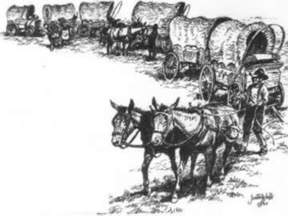 This summer when Bob and I were in the Black Hills, we were looking around in the gift shop at Mount Rushmore, when I came across a book called “Women’s Diaries Of The Westward Journey.” Since then, I have been thinking about what it must have been like to travel in a covered wagon…especially for a woman. Of course, times were different back then, and people did not have the luxury of a daily shower, or even a real bathroom…and that was in their own homes. So, imagine what life would be like on a wagon, traveling in a wagon train headed west in the mid-1800s. As the emigrants were traveling west, they were making their own roads, hunting their own food, and cooking over a campfire. For a lot of people, I’m sure this sounds like going camping, but then imagine doing it for months at a time. A day’s travel averaged about twelve to twenty miles, meaning that on the plains, they often stopped for the day within sight of the site they had just left that morning. For travelers now, that would seem insanely slow, but for the wagon trains, it was just the normal day’s journey. They knew no other way.
This summer when Bob and I were in the Black Hills, we were looking around in the gift shop at Mount Rushmore, when I came across a book called “Women’s Diaries Of The Westward Journey.” Since then, I have been thinking about what it must have been like to travel in a covered wagon…especially for a woman. Of course, times were different back then, and people did not have the luxury of a daily shower, or even a real bathroom…and that was in their own homes. So, imagine what life would be like on a wagon, traveling in a wagon train headed west in the mid-1800s. As the emigrants were traveling west, they were making their own roads, hunting their own food, and cooking over a campfire. For a lot of people, I’m sure this sounds like going camping, but then imagine doing it for months at a time. A day’s travel averaged about twelve to twenty miles, meaning that on the plains, they often stopped for the day within sight of the site they had just left that morning. For travelers now, that would seem insanely slow, but for the wagon trains, it was just the normal day’s journey. They knew no other way.
People back then would have been somewhat crazy to set out alone for the west…or to set out any later than spring, because either scenario was bound to fail. They needed the protection of the wagon train, as well as the 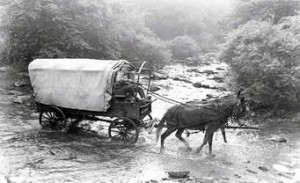 additional supplies, should a wagon be lost to fire, a river crossing, or an attack by Indians. It was their back up plan. They couldn’t just stop at the next town at a store and buy more supplies. There were no towns, stores, or even roads. When we travel, even in the rural state of Wyoming that I live in, we are used to seeing miles with very little to catch the eye, other that an occasional farm house, and an occasional town, but remember that we have roads to follow so we don’t lose our way. And even then, many of us use GPS to make sure we are taking the right road. They had none of that. They had to use the sun and landmarks to make sure they were going the right direction. They depended on people who had taken this trip before them. It was all they had. I think most of us today would go nuts if we never saw a house, a road, or a town. We would wonder if we were insane for setting out on this crazy adventure at all. One woman wrote to her husband, who was waiting at the end of the line, with the spelling ability she had at the time, “I can tell you nothing only that were hear and its strange I wish we had never started … it seems impossible to get their.” She had set out in a wagon train with her four children, without her husband, and that in itself must have been scary.
additional supplies, should a wagon be lost to fire, a river crossing, or an attack by Indians. It was their back up plan. They couldn’t just stop at the next town at a store and buy more supplies. There were no towns, stores, or even roads. When we travel, even in the rural state of Wyoming that I live in, we are used to seeing miles with very little to catch the eye, other that an occasional farm house, and an occasional town, but remember that we have roads to follow so we don’t lose our way. And even then, many of us use GPS to make sure we are taking the right road. They had none of that. They had to use the sun and landmarks to make sure they were going the right direction. They depended on people who had taken this trip before them. It was all they had. I think most of us today would go nuts if we never saw a house, a road, or a town. We would wonder if we were insane for setting out on this crazy adventure at all. One woman wrote to her husband, who was waiting at the end of the line, with the spelling ability she had at the time, “I can tell you nothing only that were hear and its strange I wish we had never started … it seems impossible to get their.” She had set out in a wagon train with her four children, without her husband, and that in itself must have been scary.
Days on the wagon train began long before dawn with a simple breakfast of coffee, bacon, and dry bread. After breakfast, the people secured their supplies, hitched up their teams, and hit the trail by seven o’clock in the morning. Most people walked because of lack of space, and the fact that the wagon was so uncomfortable. The 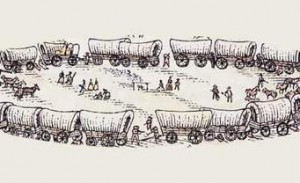 train stopped at noon for a cold meal of coffee, beans, and bacon, which had been prepared that morning. During this break, called nooning, men and women would gather and talk, children would play, and animals would rest. After that, the travel would continue until around six o’clock in the evening, when they wagons would circle for the night. Some people would visit after supper, but most went to bed, because they were exhausted. Some slept in the wagon, but most slept on the ground, because oddly enough it was more comfortable. While traveling west on the wagon trains was a necessary journey to be made to grow this country, it was not an easy journey to make, and for that reason, I have to stand in awe of those who did it.
train stopped at noon for a cold meal of coffee, beans, and bacon, which had been prepared that morning. During this break, called nooning, men and women would gather and talk, children would play, and animals would rest. After that, the travel would continue until around six o’clock in the evening, when they wagons would circle for the night. Some people would visit after supper, but most went to bed, because they were exhausted. Some slept in the wagon, but most slept on the ground, because oddly enough it was more comfortable. While traveling west on the wagon trains was a necessary journey to be made to grow this country, it was not an easy journey to make, and for that reason, I have to stand in awe of those who did it.

